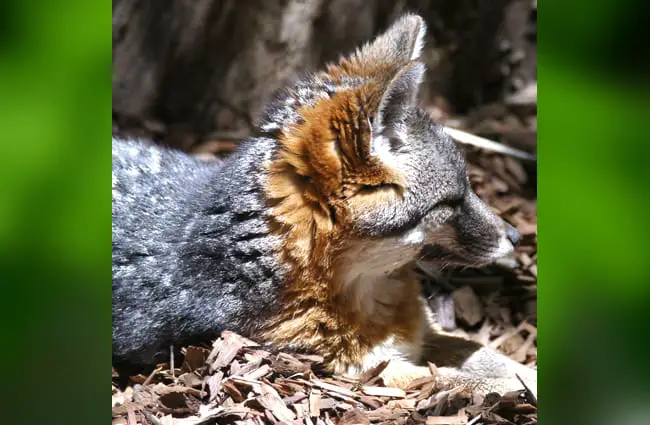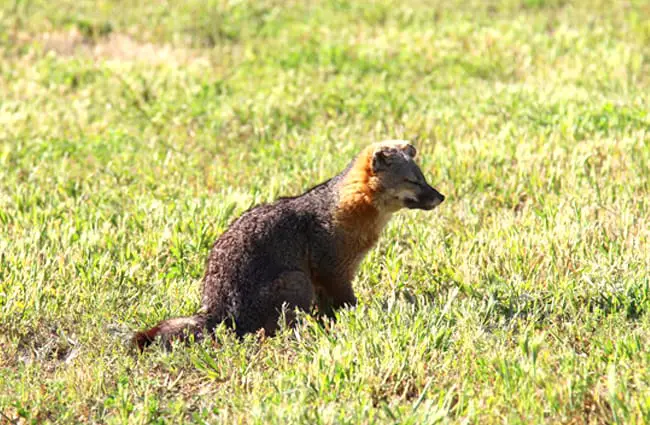The Island Fox is a small species of fox that lives only on the Channel Islands off the coast of California. Researchers recognize six different species, which live on six different islands in the island chain.
Scientists believe that this species descended from the gray fox, however these foxes are significantly smaller than their mainland cousins. Read on to learn about the Island Fox.
Description of the Island Fox
Outside of its small stature, this fox looks quite similar to the gray fox. Its coat is primarily gray colored, and it has patches of reddish-brown, black, and white fur.
Its rusty hues usually occur around the neck, on the chest, legs, and the underside of the tail. The Island is the smallest species of fox in the United States. It measures about two feet long, and weighs just four or four and a half pounds.
Interesting Facts About the Island Fox
It’s pretty undeniable that this fox is a cute little animal. However, this pint-sized fox is still an impressive predator. Learn more about what makes these foxes unique below.
- Friendly Fox – Like many island species, these foxes are surprisingly tolerant of humans. However, just because they are friendly doesn’t mean you should interact with them. You should never interact with, feed, or harass any wild animal.
- Island Introduction – Researchers still aren’t quite sure how this species ended up on the Channel Islands. We do know that the foxes landed on the northern islands sometime between 10,400 years ago and 16,000 years ago.
- Numerous Names – People refer to this fox species by several different names, including Channel Islands Fox, Island Gray Fox, Coast Fox, California Channel Islands Fox, and more.
Habitat of the Island Fox
There are several different types of habitats on the Channel Islands, and Island Foxes occupy all of them. They inhabit coastlines, sand dunes, grasslands, marshes, foothills, woodlands, chaparral, scrub, sagebrush, and more.
Generally, they prefer ecosystems with dense underbrush to hide and hunt in. They are not particularly fearful of humans, but most do not live in areas where they come in close contact with manmade habitats.
Distribution of the Island Fox
These foxes live only on the Channel Islands island chain off the coast of California. The six different subspecies live on six different islands in the chain.
They live on San Miguel Island, Santa Rosa Island, Santa Cruz Island, San Nicolas Island, Santa Catalina Island, and San Clemente Island. A small population also lives in several different zoos and breeding programs.
Diet of the Island Fox
Like most foxes, this one is omnivorous, and eats both plants and animals. Their diet consists primarily of fruits, berries, and insects. They eat a wide variety of different fruits and berries, including prickly pear cactuses, sea figs, manzanita, saltbush, and more.
These foxes also hunt a variety of insects and invertebrates, as well as mice, small birds, lizards, frogs, and more. Their diet changes slightly based on the season and the island they live on.
Island Fox and Human Interaction
Even though humans and human activity do not scare these foxes, they do not interact with humans very frequently. Most live on islands that humans rarely set foot on.
Each subspecies faces different levels of danger from human activity, and their primary threats are habitat destruction and feral cats eating their prey. Native Americans in the region also hunted the foxes and used them in religious ceremonies. The IUCN lists the Island Fox as Near Threatened.
Domestication
It is possible the Native Americans partially domesticated this fox species. However, researchers are unsure of the extent to which they interacted with and bred the Island Fox.
Does the Island Fox Make a Good Pet
No, these animals do not make good pets. Even though they are friendly, you do not want an Island Fox as a pet. Their population numbers are quite limited, and each fox is important for the survival of the species. For this reason and many other reasons, it is illegal for you to own one as a pet.
Island Fox Care
Some zoos house these foxes for breeding programs. These breeding programs care for the foxes, choose the most genetically diverse pairs, and then release animals back into the wild. The Santa Barbara Zoo was one of the first zoos to begin a captive breeding program for Island Foxes.
Their enclosures provide plenty of space for exercise, tunnels or dens to hide in, and a variety of different toys, scents, and other mentally stimulating environmental enrichment.
Behavior of the Island Fox
Outside of the breeding season, these foxes are usually solitary. Each fox has its own territory, which it marks with urine and feces to communicate with its neighbors. They spend their nights patrolling their territory, barking to their neighbors, and hunting for food.
Breeding pairs usually live in adjacent territories, or territories next to one another. However, they only come together when it is time to breed, and spend the rest of their time alone.
Reproduction of the Island Fox
This species usually breeds with the same partner year after year. Foxes begin breeding between the months of January and April. They have a gestation period of about two months. Females usually give birth to a litter of two or three kits.
They give birth in their dens, and the kits remain in the den for a few weeks. Once they are around eight weeks old the kits stop drinking their mother’s milk and begin eating solid foods. They begin breeding themselves when they are about a year old.











![Red Angus Closeup of a beautiful Red Angus cowPhoto by: U.S. Department of Agriculture [pubic domain]https://creativecommons.org/licenses/by/2.0/](https://animals.net/wp-content/uploads/2020/03/Red-Angus-4-238x178.jpg)












![Red Angus Closeup of a beautiful Red Angus cowPhoto by: U.S. Department of Agriculture [pubic domain]https://creativecommons.org/licenses/by/2.0/](https://animals.net/wp-content/uploads/2020/03/Red-Angus-4-100x75.jpg)

